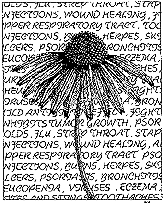The Cold Killer
Echinacea enjoys huge sales, largely due to its effectiveness at fighting the common cold
By Christina Waters
ONE OF THE PRIMARY medicines among native peoples of North America, Echinacea--purple coneflower--was used in a favorite poultice against snakebites, as a cold treatment and to ease the aches of arthritis. European settlers in the Midwest quickly adopted echinacea as a remedy, attracting the attention of the East Coast medical community, which soon sent samples of the flower and roots to colleagues across the Atlantic.
By the turn of the century, echinacea was a fixture in every medicine cabinet and enjoyed favor as a cold remedy until the raging debate between alternative healers and the American Medical Association practitioners sent its use into a steep decline. Once patent medicines and antibiotics came on the scene after World War I, echinacea almost disappeared from use in the United States.
Echinacea continued to be used, however, in Europe, especially in Germany. When the 1970s revival of herbal alternatives emerged, German researchers led the way in documenting the effectiveness of echinacea on a variety of disease-control fronts.
Today echinacea enjoys huge sales, largely due to its widely reported effectiveness against that most stubborn of maladies--the common cold. Sold in tablet, capsule, tincture and as a dried root, echinacea seems to be most potent as an extract. Confirmed users report that if taken at the first sign of scratchy throat or plugged-up nose, echinacea actually can prevent a cold from developing.
How it does this occurs in several ways, according to a body of German studies done over the past several decades. Echinacea not only acts to prevent infection from invading tissue, but also is believed to strengthen the immune system. When disease-causing organisms strike, white blood cells gather in the afflicted area to neutralize the invaders. Echinacea appears to boost the white blood cells' ability to kill germs.
Studies also indicate that it can increase levels of infection-fighting T-cells. Even more important--in terms of possible cancer-fighting implications--echinacea simulates the infection-fighting abilities of a hormone called interferon, which is produced by the body.
The wealth of positive anecdotal evidence has clearly convinced consumers and herbal practitioners alike--and more than a few mainstream physicians--that echinacea belongs in the health care arsenal. Used for hundreds of years, echinacea has never been shown to cause harm and produces only rare, occasional side effects in highly sensitive individuals.
Purists can try growing their own echinacea, using organically grown seeds packaged by Seeds of Change.
This page was designed and created by the Boulevards team.

From the July 3-10, 1996 issue of Metro
Copyright © 1996 Metro Publishing and Virtual Valley, Inc.
